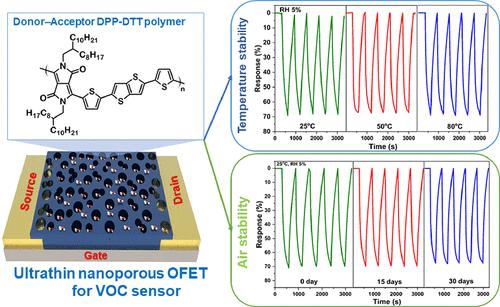当前位置:
X-MOL 学术
›
ACS Appl. Mater. Interfaces
›
论文详情
Our official English website, www.x-mol.net, welcomes your
feedback! (Note: you will need to create a separate account there.)
Design and Fabrication of Ultrathin Nanoporous Donor–Acceptor Copolymer-Based Organic Field-Effect Transistors for Enhanced VOC Sensing Performance
ACS Applied Materials & Interfaces ( IF 8.3 ) Pub Date : 2023-04-24 , DOI: 10.1021/acsami.3c00105 Vinh Van Tran 1 , Ganghoon Jeong 2, 3 , Eunsol Wi 2, 3 , Daeho Lee 1 , Mincheol Chang 2, 3, 4
ACS Applied Materials & Interfaces ( IF 8.3 ) Pub Date : 2023-04-24 , DOI: 10.1021/acsami.3c00105 Vinh Van Tran 1 , Ganghoon Jeong 2, 3 , Eunsol Wi 2, 3 , Daeho Lee 1 , Mincheol Chang 2, 3, 4
Affiliation

|
The development of organic field-effect transistor (OFET) chemical sensors with high sensing performance and good air stability has remained a persistent challenge, thereby hindering their practical application. Herein, an OFET sensor based on a donor–acceptor copolymer is shown to provide high responsivity, sensitivity, and selectivity toward polar volatile organic compounds, as well as good air stability. In detail, a polymer blend of N-alkyl-diketopyrrolo-pyrrole-dithienylthieno[3,2-b]thiophene (DPP-DTT) and polystyrene is coated onto an FET substrate via shearing-assisted phase separation (SAPS) combined with selective solvent etching to fabricate the DPP-DTT-based OFET device having an ultrathin nanoporous structure suitable for gas sensing applications. This is achieved via optimization of the film morphology by varying the shear rate to adjust the dynamic balance between the shear and capillary forces to obtain an ultrathin thickness (∼8 nm) and nanopore size (80 nm) that are favorable for the efficient diffusion and interaction of analytes with the active layer. In particular, the sensor presents high responsivities toward methanol (∼70%), acetone (∼51.3%), ethanol (∼39%), and isopropyl alcohol (IPA) (∼29.8%), along with fast response and recovery times of ∼80 and 234 s, respectively. Moreover, the average sensitivity was determined to be 5.75%/ppm from the linear plot of the responsivity against the methanol concentration in the range of 1–100 ppm. Importantly, the device also exhibits excellent long-term (30-day) air and thermal storage stability, thereby demonstrating its high potential for practical applications.
中文翻译:

基于超薄纳米多孔供体-受体共聚物的有机场效应晶体管的设计和制造,以增强 VOC 传感性能
开发具有高传感性能和良好空气稳定性的有机场效应晶体管 (OFET) 化学传感器仍然是一个持续的挑战,从而阻碍了它们的实际应用。在此,基于供体-受体共聚物的 OFET 传感器显示出对极性挥发性有机化合物具有高响应度、灵敏度和选择性,以及良好的空气稳定性。详细地,N-烷基-二酮吡咯并-吡咯-二噻吩基噻吩[3,2- b]噻吩 (DPP-DTT) 和聚苯乙烯通过剪切辅助相分离 (SAPS) 结合选择性溶剂蚀刻被涂覆到 FET 基板上,以制造具有适用于气体传感应用的超薄纳米多孔结构的基于 DPP-DTT 的 OFET 器件。这是通过改变剪切速率来优化薄膜形态来实现的,以调整剪切力和毛细管力之间的动态平衡以获得有利于有效扩散的超薄厚度(~8 nm)和纳米孔尺寸(80 nm)和分析物与活性层的相互作用。特别是,该传感器对甲醇 (~70%)、丙酮 (~51.3%)、乙醇 (~39%) 和异丙醇 (IPA) (~29.8%) 具有高响应性,同时具有快速响应和恢复时间分别为 ~80 和 234 秒。而且,根据响应度对 1–100 ppm 范围内的甲醇浓度的线性图,平均灵敏度确定为 5.75%/ppm。重要的是,该器件还表现出出色的长期(30 天)空气和热储存稳定性,从而展示了其在实际应用中的巨大潜力。
更新日期:2023-04-24
中文翻译:

基于超薄纳米多孔供体-受体共聚物的有机场效应晶体管的设计和制造,以增强 VOC 传感性能
开发具有高传感性能和良好空气稳定性的有机场效应晶体管 (OFET) 化学传感器仍然是一个持续的挑战,从而阻碍了它们的实际应用。在此,基于供体-受体共聚物的 OFET 传感器显示出对极性挥发性有机化合物具有高响应度、灵敏度和选择性,以及良好的空气稳定性。详细地,N-烷基-二酮吡咯并-吡咯-二噻吩基噻吩[3,2- b]噻吩 (DPP-DTT) 和聚苯乙烯通过剪切辅助相分离 (SAPS) 结合选择性溶剂蚀刻被涂覆到 FET 基板上,以制造具有适用于气体传感应用的超薄纳米多孔结构的基于 DPP-DTT 的 OFET 器件。这是通过改变剪切速率来优化薄膜形态来实现的,以调整剪切力和毛细管力之间的动态平衡以获得有利于有效扩散的超薄厚度(~8 nm)和纳米孔尺寸(80 nm)和分析物与活性层的相互作用。特别是,该传感器对甲醇 (~70%)、丙酮 (~51.3%)、乙醇 (~39%) 和异丙醇 (IPA) (~29.8%) 具有高响应性,同时具有快速响应和恢复时间分别为 ~80 和 234 秒。而且,根据响应度对 1–100 ppm 范围内的甲醇浓度的线性图,平均灵敏度确定为 5.75%/ppm。重要的是,该器件还表现出出色的长期(30 天)空气和热储存稳定性,从而展示了其在实际应用中的巨大潜力。





















































 京公网安备 11010802027423号
京公网安备 11010802027423号